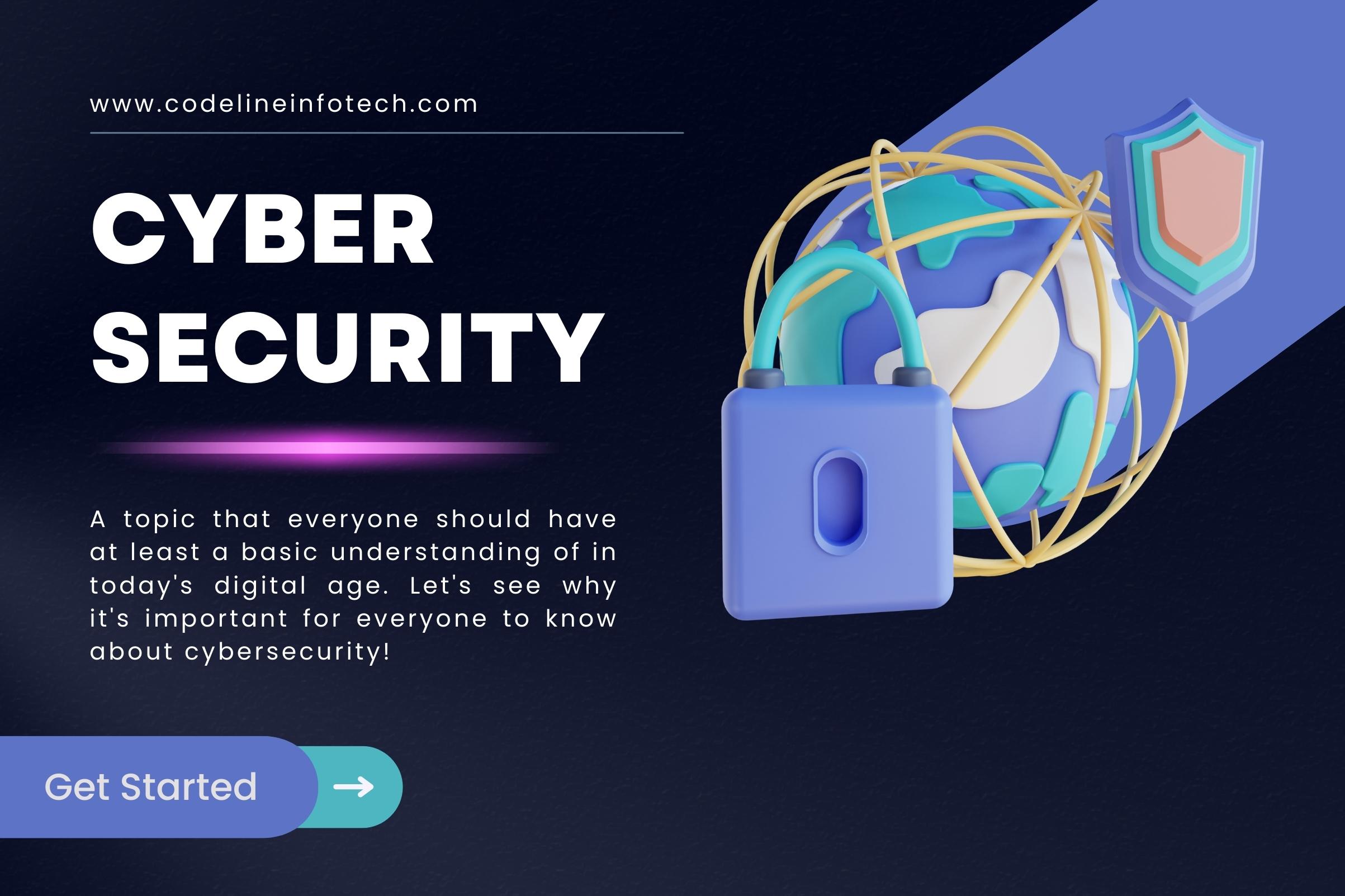BlogRead Our Latest Project

The Importance of Cybersecurity
Cybersecurity
Cybersecurity refers to the practice of protecting computer systems, networks, and data from unauthorized access, use, disclosure, disruption, modification, or destruction. It involves the implementation of various measures, technologies, and best practices to safeguard digital information and mitigate the risks posed by cyber threats.
A strong cybersecurity strategy can provide a good security posture against malicious attacks designed to access, alter, delete, destroy or extort an organization's or user's systems and sensitive data. Cybersecurity is also instrumental in preventing attacks that aim to disable or disrupt a system's or device's operations.
The Importance of Cybersecurity
As more people, devices, and software are used in businesses today, along with a large amount of data, much of it being private or sensitive, the need for cybersecurity keeps getting more important. Moreover, the increasing number and advanced skills of hackers and their attack methods make the situation even more challenging.
Here are some key reasons why cybersecurity is crucial:
1. Protection of Confidential Information: Cybersecurity measures are vital for safeguarding confidential and sensitive information. Whether it's personal data, financial records, intellectual property, or trade secrets, organizations and individuals need to ensure that such information remains secure and is not accessed or compromised by unauthorized individuals.
2. Mitigation of Financial Loss: Cyberattacks can result in significant financial losses for businesses. The costs associated with recovering from an attack, including incident response, system repairs, legal fees, customer notification, and potential regulatory fines, can be substantial. Implementing cybersecurity measures helps reduce the risk of financial loss due to cyber threats.
3. Safeguarding National Security: Cybersecurity plays a vital role in ensuring national security. Governments and defense organizations need robust cybersecurity measures to protect sensitive information, communication networks, and critical defense systems from cyber threats and potential cyber warfare. A breach or compromise of such systems can have severe implications for a nation's security and defense capabilities.
4. Ensuring Integrity: Cybersecurity ensures the integrity of data and systems by preventing unauthorized modifications, alterations, or deletions. It ensures that data remains accurate, consistent, and reliable.
5. Ensuring Availability: Cybersecurity measures aim to ensure the availability of information and resources when needed. By preventing cyber attacks and disruptions, organizations can maintain the availability of critical services and systems.
What are the elements of cybersecurity and how does it work?
The field of cybersecurity encompasses several key elements that work together to protect computer systems, networks, and data from cyber threats. These elements include:
1. Risk Assessment
2. Prevention
3. Detection
4. Incident Response
5. Vulnerability Management
6. Encryption
7. User Awareness and Training
8. Security Governance
These elements work together to create a layered approach to cybersecurity, known as defense-in-depth. By implementing multiple layers of security measures, organizations can increase their overall resilience to cyber threats. It is important to note that cybersecurity is a continuous and evolving process that requires ongoing monitoring, assessment, and adaptation to address emerging threats and vulnerabilities.
What are the benefits of cybersecurity?
The benefits of implementing and maintaining cybersecurity practices include:
· Business protection against cyberattacks and data breaches.
· Protection for data and networks.
· Prevention of unauthorized user access.
· Improved recovery time after a breach.
· Protection for end users and endpoint devices.
· Regulatory compliance.
· Business continuity.
· Improved confidence in the company's reputation and trust for developers, partners, customers, stakeholders and employees.
Overall, cybersecurity benefits individuals, organizations, and society by protecting sensitive data, preventing financial losses, maintaining business continuity, safeguarding reputation, preserving privacy, protecting intellectual property, enhancing national security, and promoting trust in the digital landscape. It is an essential component of our increasingly interconnected and technology-driven world.
What are the different types of cybersecurity threats?
Cybersecurity threats come in various forms, each with its own characteristics and potential impacts. Here are some of the different types of cybersecurity threats:
1. Malware: Malware refers to malicious software designed to disrupt, damage, or gain unauthorized access to computer systems. It includes viruses, worms, Trojans, ransomware, spyware, and adware. Malware can be spread through infected email attachments, malicious websites, or compromised software.
2. Ransomware: Ransomware is a type of malware that encrypts a victim's data, rendering it inaccessible until a ransom is paid. It often spreads through malicious email attachments, infected websites, or vulnerabilities in software. Ransomware attacks can have severe financial and operational consequences for individuals and organizations.
3. Denial-of-Service (DoS) and Distributed Denial-of-Service (DDoS) Attacks: DoS attacks aim to make a computer system or network unavailable to users by overwhelming it with a flood of illegitimate requests or by exploiting vulnerabilities. DDoS attacks involve multiple systems, often using botnets, to launch a coordinated attack, rendering the targeted system or network unable to function effectively.
4. Phishing: Phishing is a social engineering technique where attackers impersonate trustworthy entities to trick individuals into revealing sensitive information, such as passwords, credit card details, or personal data. Phishing attacks often occur through deceptive emails, fake websites, or instant messages, aiming to manipulate recipients into taking actions that benefit the attacker.
5. Social Engineering: Social engineering is a technique that manipulates individuals to gain unauthorized access to systems or sensitive information. Attackers exploit human psychology and trust, using tactics such as pretexting, baiting, or tailgating to deceive individuals and gain access to confidential data or critical systems.
Cyber safety tips - protect yourself against cyberattacks
Protecting yourself against cyberattacks is crucial in today's digital world. Here are some essential cyber safety tips to help you stay safe online:
1. Use Strong and Unique Passwords: Create strong, complex passwords for your online accounts and avoid using the same password for multiple accounts. Consider using a password manager to securely store and generate unique passwords.
2. Enable Two-Factor Authentication (2FA): Activate 2FA whenever possible. This adds an extra layer of security by requiring a second verification step, such as a code sent to your phone, in addition to your password.
3. Keep Software Up to Date: Regularly update your operating system, web browsers, and other software applications to ensure you have the latest security patches and fixes. Enable automatic updates whenever possible.
4. Be Cautious with Email and Attachments: Exercise caution when opening emails, especially from unknown senders or those that seem suspicious. Avoid clicking on links or downloading attachments from untrusted sources, as they may contain malware or lead to phishing websites.
5. Regularly Back Up Your Data: Create regular backups of your important files and data and store them securely. In case of a ransomware attack or data loss, having backups ensures you can restore your information without paying a ransom or losing critical data.
6. Use Trusted Security Software: Install reputable antivirus and anti-malware software on your devices and keep them updated. Regularly scan your system for potential threats and remove any detected malware.
7. Be Mindful of Personal Information Sharing: Be cautious about sharing personal information online, especially on public forums or social media platforms. Limit the amount of personal information you provide, and adjust privacy settings to control who can access your information.
8. Educate Yourself about Cyber Threats: Stay informed about the latest cyber threats and trends. Educate yourself about common attack techniques, such as phishing, malware, and social engineering, to recognize and avoid potential risks.







